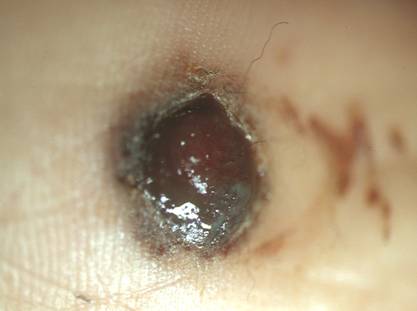
Neurofibromatosis is the name for a disorder that affects the skin and nervous system. this disorder is divided into two groups: Neurofibromatosis Type 1 (NF-1, also known as von Recklinghausen’s disease) and Neurofibromatosis Type 2 (NF-2). Type 1 is the most common. this disorder is occurs in approximately 1 in 40,000 people. some experts suspect that it is an inherited disorder which can affect both males and females alike. Mutations of the affected gene can cause the disorder even when no one else in the family has it. only one copy of the affected gene needs to be passed on in order for it to develop. The child of an affected parent has a 50% chance of developing this condition. To diagnose this disease the medical doctor will take a family medical history and do a physical exam. Testing will be done on hearing as well as an EEG. X-rays of the bones and a CT scan or MRI scan of the head may also be done. Neurofibromatosis symptoms usually show up by the age of 10.
Neurofibromatosis symptoms for Type 1 are usually limited to the skin and eyes, nervous system and may present joint and bone manifestations. The common symptoms include markings on the skin called Café au lait (“coffee with milk”). it is common to find 5 or more of these tan patches on the skin. These spots usually develop within the first few years of life. They are commonly found on the scalp, palms of the hands and soles of the feet but they can also occur on other parts of the body. during puberty the spots multiply and darken when exposed to the sun. Such spots can look like freckles only they appear where the sun does not reach, like the arm pits or groin. this freckling is not dangerous but may cause the skin to itch.
Lisch nodules, pigmented bumps found within the iris of the eyes, are associated with Type 1 Neurofibromatosis. The lisch nodules usually do not cause vision problems for most people and usually do not occur until late childhood. These nodules are one of the major signs of neurofibromatosis. The skin can also develop small, rubbery skin lesions called neurofibromas. These tumors consist of an intense co-mingling of nerve cells and fibrous tissue. Bone defects and visual disorders may also be symptoms of this disease. Type 1 can also be complicated by masses on the brain or spinal column.
Neurofiromatosis Type 2 is the rarer form of this disease and is diagnosed in only about 10% of the cases. Symptoms of Neurofibromatosis Type 2 include bilateral acoustic neuromas. These neuromas are tumors on the eight cranial nerves in the brain. Hearing loss, headache, facial weakness and loss of balance are all symptoms of Type 2. Other symptoms can include brain tumors and abnormalities in the eye lenses. Café-au-lait spots are not as common in Type 2 Neurofibromatosis. Skin tumors are not as common in this type either but may also be present. People who are diagnosed with Nerurofibromotosis Type 1 have a better prognosis then those who are diagnosed with Type 2.
There are no treatments for Neurofibromatosis symptoms other than removal of the tumors if they are causing vision loss or other complications. The neurofibromas are small pea-sized nodules that develop along the nerves in the body. They are slow growing and not cancerous. some people with this condition can be afflicted all over their body with these tumors. others may only have a few. People who are diagnosed with this condition are given genetic counseling and made known of their chances for passing this condition to their offspring.